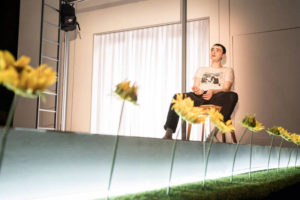 (4 / 5)
(4 / 5)
The Royal Court does a wonderful thing with it’s writing/writers. There always tends to be a simple premise – a production will often start as normal as possible, with it then changing and surprising you through time.
Instructions for Correct Assembly, written by Thomas Eccleshare and directed by Hamish Pirie features a plain family – Mother, Father and Son. They have fun neighbours who are their best friends, who boast excellent children which always feels like a comparison. Their home is perfect, precise and generally like an Ikea show room.
There is a difference to this story however – as time goes by we see flash backs of their son who finds himself deteriorating in life; their struggle to help and eventually their resistance after the last straw. And once he is gone, their need to fill the void. In this futuristic world, the void is in the shape of a robot son.
The narrative is relatable even though the events seem a little impossible in our current world. We relate to the characters, feel what they feel, laugh at the right parts, but we also question how we would take the situation.
Jane Horrocks, of Little Voice and Ab Fab fame takes a front seat in this production as our mother. She is as homely and approachable as a stereotyped mother is. It’s nice to see her in a more ‘ordinary’ role in comparison to the hyper-comical characters we are used to seeing her in.
Mark Bonnar, known for Shetland and Apple Tree Farm is the doting husband and father who is easily bent by his son. He does well to play this goody-teacher type but together with Horrocks, evokes the emotion and feelings of a Mother and Father duo who are distress and worry for their son.
Brian Vernel does a fantastic job in a double role as our robot and the human son. His movements in comparison to the two characters are distinguished and differentiate them very easily. But he is also believable. As if this situation is real in our current society.
My only issue with the acting is at times when they have been instructed to move in jumpy motions, I can only assume to represent ‘models’/’robots at their basic moments, but this doesn’t feel like it fits. While I can see what they have done and why, and it does seem fitting, it just felt disjointed to the process of the production.
A review cannot be left without a comment on the staging and lighting/sound. Design is by Cai Dyfan and lighting by Jack Knowles. The Royal Court is known for its unusual take on these and this is no exception. For the ‘perfect’ family, the rooms look like they are all made of Ikea furniture and works well with the narrative, especially as the characters like to build flat packs. Slowly as the perfection breaks down, parts of the staging come away, revealing more emptiness, possibly close to how they feel. Finally a large natural wall of flowers and fauna appears at the back – an argument against robotics in comparison to naturalism? For whatever reason, this adds such depth and interest to the so far basic, perfect rooms.
Instructions for Correct Assembly is an interesting and inventive piece of theatre. While the concept of the breakdown of robotics in our future is a common topic, there is something more human and certainly different to similar writings.



